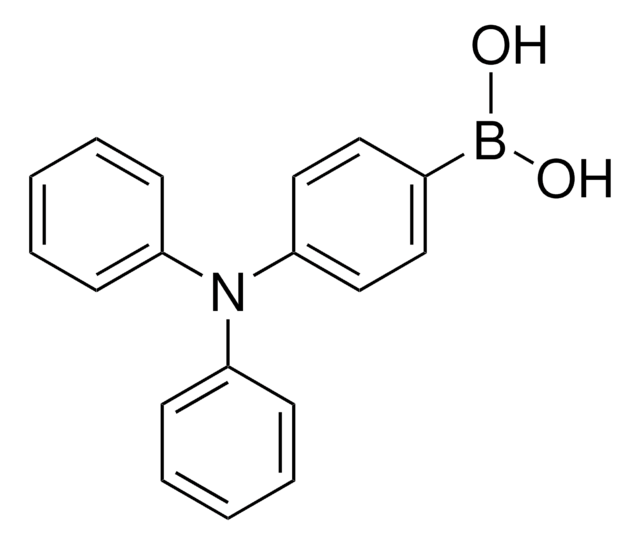929476
N-Acetyl-S-(2-amino-9-(4-fluorobenzyl)-6-oxo-6,9-dihydro-1H-purin-8-yl)-L-cysteine
≥95%
Synonyme(s) :
p-Fluorobenzylguanine ligand, AUTAC ligand, FBnG
Se connecterpour consulter vos tarifs contractuels et ceux de votre entreprise/organisme
About This Item
Formule empirique (notation de Hill):
C17H17FN6O4S
Numéro CAS:
Poids moléculaire :
420.42
Numéro MDL:
Code UNSPSC :
12352209
Nomenclature NACRES :
NA.21
Produits recommandés
Niveau de qualité
Pureté
≥95%
Forme
powder or chunks
Pertinence de la réaction
reagent type: ligand
Température de stockage
2-8°C
Chaîne SMILES
O=C1NC(N)=NC2=C1N=C(SC[C@@H](C(O)=O)NC(C)=O)N2CC3=CC=C(C=C3)F
Application
N-acetyl-S-(2-amino-9-(4-fluorobenzyl)-6-oxo-6,9-dihydro-1H-purin-8-yl)-L-cysteine is a p-fluorobenzylguanine (FBnG) based ligand used to initiate selective autophagy as a strategy for targeted protein degradation and PROTAC (proteolysis-targeting chimeras) technology.
Related Technology Spotlight: Degrader Building Blocks for Targeted Protein Degradation
Browse our growing synthesis and research tools: Protein Degrader Building Blocks
Related Technology Spotlight: Degrader Building Blocks for Targeted Protein Degradation
Browse our growing synthesis and research tools: Protein Degrader Building Blocks
Autres remarques
AUTACs: Cargo-Specific Degraders Using Selective Autophagy
Iterative Design and Optimization of Initially Inactive Proteolysis Targeting Chimeras (PROTACs) Identify VZ185 as a Potent, Fast, and Selective von Hippel-Lindau (VHL) Based Dual Degrader Probe of BRD9 and BRD7
BAF complex vulnerabilities in cancer demonstrated via structure-based PROTAC design
Cereblon versus VHL: Hijacking E3 ligases against each other using PROTACs
Systematic exploration of different E3 ubiquitin ligases: an approach towards potent and selective CDK6 degraders
Iterative Design and Optimization of Initially Inactive Proteolysis Targeting Chimeras (PROTACs) Identify VZ185 as a Potent, Fast, and Selective von Hippel-Lindau (VHL) Based Dual Degrader Probe of BRD9 and BRD7
BAF complex vulnerabilities in cancer demonstrated via structure-based PROTAC design
Cereblon versus VHL: Hijacking E3 ligases against each other using PROTACs
Systematic exploration of different E3 ubiquitin ligases: an approach towards potent and selective CDK6 degraders
Informations légales
PROTAC is a registered trademark of Arvinas Operations, Inc., and is used under license
Produit(s) apparenté(s)
Réf. du produit
Description
Tarif
Code de la classe de stockage
11 - Combustible Solids
Classe de danger pour l'eau (WGK)
WGK 3
Point d'éclair (°F)
Not applicable
Point d'éclair (°C)
Not applicable
Certificats d'analyse (COA)
Recherchez un Certificats d'analyse (COA) en saisissant le numéro de lot du produit. Les numéros de lot figurent sur l'étiquette du produit après les mots "Lot" ou "Batch".
Déjà en possession de ce produit ?
Retrouvez la documentation relative aux produits que vous avez récemment achetés dans la Bibliothèque de documents.
William Farnaby et al.
Nature chemical biology, 15(7), 672-680 (2019-06-11)
Targeting subunits of BAF/PBAF chromatin remodeling complexes has been proposed as an approach to exploit cancer vulnerabilities. Here, we develop proteolysis targeting chimera (PROTAC) degraders of the BAF ATPase subunits SMARCA2 and SMARCA4 using a bromodomain ligand and recruitment of
Miriam Girardini et al.
Bioorganic & medicinal chemistry, 27(12), 2466-2479 (2019-03-04)
The von Hippel-Lindau (VHL) and cereblon (CRBN) proteins are substrate recognition subunits of two ubiquitously expressed and biologically important Cullin RING E3 ubiquitin ligase complexes. VHL and CRBN are also the two most popular E3 ligases being recruited by bifunctional
Christian Steinebach et al.
Chemical science, 11(13), 3474-3486 (2020-11-03)
Cyclin-dependent kinase 6 (CDK6) is an important regulator of the cell cycle. Together with CDK4, it phosphorylates and inactivates retinoblastoma (Rb) protein. In tumour cells, CDK6 is frequently upregulated and CDK4/6 kinase inhibitors like palbociclib possess high activity in breast
Daiki Takahashi et al.
Molecular cell, 76(5), 797-810 (2019-10-14)
Protein silencing represents an essential tool in biomedical research. Targeted protein degradation (TPD) strategies exemplified by PROTACs are rapidly emerging as modalities in drug discovery. However, the scope of current TPD techniques is limited because many intracellular materials are not
Vittoria Zoppi et al.
Journal of medicinal chemistry, 62(2), 699-726 (2018-12-13)
Developing PROTACs to redirect the ubiquitination activity of E3 ligases and potently degrade a target protein within cells can be a lengthy and unpredictable process, and it remains unclear whether any combination of E3 and target might be productive for
Notre équipe de scientifiques dispose d'une expérience dans tous les secteurs de la recherche, notamment en sciences de la vie, science des matériaux, synthèse chimique, chromatographie, analyse et dans de nombreux autres domaines..
Contacter notre Service technique








